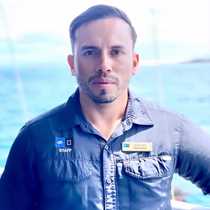Fernandina & Isabela Island
Today we navigated toward the youngest of all the enchanted islands, the youngest jewel in the crown. Over the very calm waters of Bolivar Canal the National Geographic Endeavour sailed, and we soon saw the first signs of La Cumbre Volcano, which is the mother volcano that created the Island of Fernandina…
We had arrived at the westernmost island of the archipelago; we landed at a place guarded by mangroves around its entrance, known as Punta Espinoza. The land of endemic wonders I call it, some big, some small, but tons of them, dark and marine. Yes! Hundreds of marine iguanas sitting on the very young lava fields, warming up, digesting and perfectly camouflaged against the rusty volcanic black lava. As we followed our trail, we spotted cormorants, pelicans and striated herons; young sea lions in the tide pools offered us quite a playful show.
A snorkeling outing took us to explore the underwater life around Fernandina. Some Pacific green sea turtles welcomed us with a nice and gentle swimming experience right next to them; some endemic cormorants and penguins were also in the water, sharing their agile hydrodynamic movements.
We soon navigated to the second youngest island, this one being the largest of all: Isabela Island. We had a zodiac ride around the giant cliffs of a collapsed caldera, and some of us were lucky to spot two tropical whales in the area. Along the shoreline, penguins and cormorants were numerous and we saw blue-footed boobies flying or sitting on the compacted ash walls.
It certainly was a place like no other, where we could see two species that came from the northern and southern hemispheres (sea lions and penguins), sitting together on the same rock, here in the enchanted archipelago.




